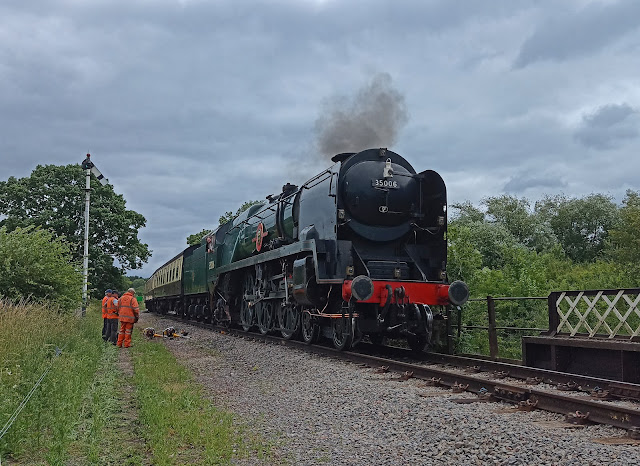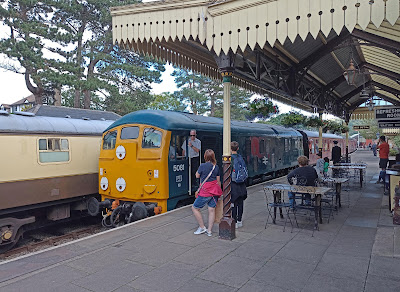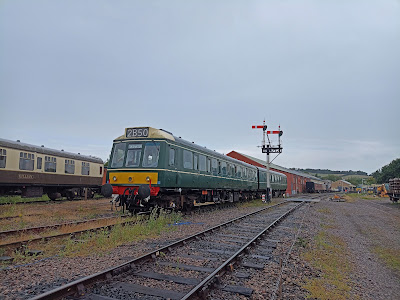Friday 30th on the steels.
Visit your railway! It's always interesting.
You'll be reading this a fortnight after the last post, due to a friendly visit to Wales. So the news won't be that hot, but you might be interested in this delivery, as we found it on Friday morning (the 30th, that is).
A large diesel engine was about to be launched down the alleyway of the unloading road. What's it doing here?
It's for our forthcoming diesel gala. Read more about it here. That engine figures right at the top!
https://www.gwsr.com/events/diesel-gala
Moments later the eagle had landed, and a shunter moved in to pick it up.
It rolled past the window of the mess room, so we peeked out to catch sight of its number (that is important to some of you...)
It turns out to be the last Beyer Peacock built class 25. Read more about its life here, if interested:
https://www.derbysulzers.com/25309.html
It fits in rather well with our new goods shed style mess room, and those lovely copper lamps that we fitted along it.
We too a picture of the works plate too. Built in 1966, so quite late in the day. Beyer Peacock always was a sign of quality.
On to the cleaning of the angles for Broadway P2.
Saturday 1st July on the PWay
A special trip Saturday a week ago, with the mini digger on a trailer behind the Ranger to Gotherington Skew yard.
Here we are inspecting the arrival. What now?
Well, the anwer was to get the digger off the trailer, whereafter Dave gave it the once over, a bit of a clean around the moving parts, and a thorough greasing, ready for the day.
 |
| Black sheep of the family? What do you mean? |
The view from Gotherington Skew is one of our favourites (you can't see any housing estates). This flock of sheep was grazing peacefully but seemed to wander off when we started work.
- Dave and Mike filled dumpy bags with ballast. These 1 ton loads should make it more efficient to drop ballast along the line with the RRV. The alternative way was to use a Dogfish, but it will only discharge all of its 20 ton load at once.
- Bert Ferrule and Nick went off to Manor Lane to replace a broken fishplate
- The other 4 set out the site boards (1/4 mile each way) and started packing joints by the big bridge.
As the site was a bit crowded we pushed the trailer into the weeds to get it out of the way.
Dave and Mike were filling Dumpy bags. Initially it was intended to use a frame to hold the sides of the bag up, but it was soon realised that we might as well hang the loops on the forks of the Telehandler straight away, as that was used to park the full bags over by the sleeper piles.
Those on the Robels by the Skew Bridge had to let an occasional train pass.
This area was disturbed when the track was lifted a few years ago to have the bridge repainted, and it is taking several years to settle down. The joint between lifted and remaining track needed packing again.
Here too a little wait while we let a southbound train go by. The slight cant and raised bed make for nice photographs.
This is one of the sleepers marked with an 'X'.
That 'X' is so easy to apply, and so hard to cure.
Digging out the sleeper was harder than usual here, as in the day larger diameter, but cheaper, ballast was used. It's very hard to insert a shovel into these boulders. Smaller diameter grey coloured ballast, recently dropped, can be seen on the left.
The replacement sleeper was a new one, pre drilled. Unfortunately the standard cast iron S1 chairs are not used on the bridge, but shallower PAN11 base plates. So the holes don't match.
If you want the sleeper to last you need to plug the old holes with wooden spiles.
'Newbie' Graham got the spile in so far, then obliterated the rest... we told him that meant a round of Magnums for the gang when we got back...
Then we got ready to leave - we need to hit the Coffeepot back at Winchcombe before closure.
We then watched Dave drive the little digger back on to the trailer. No problems here, and Winchcombe was not far away. But it was several curves on the road away - on one of them the box of doughnuts on the dashboard slid from one side to the other, a doughnut fell out and shot out of the window!
Monday with STEVIE.
STEVIE's first day out along the rails. Finally he's being used for what he was designed, heavy lifting along the trackside.
Stevie went to Toddington for his first outing, to pick up some of the track components that were replaced last winter. Walt made an excellent stop frame video, which he kindly agreed we could post here, so enjoy.
And here he is back home, on the siding at Winchcombe, having brought back a crossing from Toddington.
Last Wednesday on the Usk project.
We spent 4 days in Wales, but thanks to Dave we can have a peep behind the scenes and see what they did back in Winchcombe. Here are his pictures of the day.
Much of the day was spent on cabling for an overhead light. Steve brought a length of cable that not only reached to the central truss, but also enough to fill a conduit under the floor to the opposite side of the building. It's a conduit that we put in, just in case, since we had the opportunity.
The cable run started by the consumer unit by the door, where the underfloor conduit also comes out.
As we explained in the previous post, this consumer unit and its associated power socket will be hidden by a lectern that Paul is making.
The cable was routed over the door...
...and then through the corner rock and up to the roof.
We would have liked to have hidden it even more, but there was no obvious way.
Here you can also see the cable that was sent undergound inside the conduit, to emerge inside the front wall on the far side of the floor.
We're going to hide all this obligatory modern stuff with Paul's specially made lectern.
Finally Paul ran it along the top of the truss and let it emerge underneath.
We still need to think of some sort of period lamp shade.
Diesel gala - Saturday 8th July.
A few impressions. It was a PWay working day, but that didn't happen. We couldn't work along the line because of the intensive rail traffic, and the alternative yard work was rained out by heavy showers all day.
So we decided to afford ourselves a trip on the cushions to see what the ride was actually like, from the inside as it were.
While still drinking tea and mulling opportunities on what was a very showery day the class 20 whistled by.
That whistling is handy. When you hear it, you have time to get up and get the camera out.
The passing of the class 20 was followed by the DMU. But it didn't go to Toddington as expected, but it came to hide in the C&W approach road.
That made for an interesting move, and this picture of it off the main line for once.
This stabling move was repeated throughout the day, so we were able to photograph the DMU again from the other side, but now with the class 20 on the main line.
Four of the 8 assembled today decided to test the ride to CRC. It was surprisingly good, which was nice. So our repeated robelling in various places was working. We didn't notice any particular bumps or wobbles, just a gentle trundle through the Gloucestershire countryside.
The ostensible reason for a trip to CRC was to test the ride, but perhaps the real reason was to score a few bacon butties from the griddle, which had been relocated from Winchcombe to CRC.
Cheltenham too has its B&Q shed, as now in Broadway....
Last picture of the Diesel gala - the grey class 47 rumbles in to Winchcombe.
Tuesday 11th July - on steels (again).
Back from Wales, and back on there grind (as it were).
We are still grinding off mill scale and rust, but are doing well. Neal and John got quite a bit done while we were away (two sessions) and at the end of today we were almost there. With the first load, anyway.
First thing, we had a bit of a walk around to see what we have missed. Curiosity was also piqued, when we saw a low loader disappear back up the drive. Empty. Eh?
The first thing of note was Peckett JOHN, one of the original little locos that pulled our trains in the very early days.
It is currently being restored, with significant boiler works ongoing.
For once it was out in the open.
The canopy gang got back to work - fittingly under a canopy, albeit an ugly one - and during the day we cleaned up another 8 lengths of angle.
Mid afternoon we had a tremendous downpour. Below are two pictures of the same thing, the Cotswolds edge above Hayles abbey, from our work site.
Now you see it, now you don't !
It came absolutely bucketing down - can you see it bouncing on the open foundations next to us?
We stayed dry, or almost. Due to wind some rain did get driven underneath our roof, but as the air was warm it soon evaporated again. Phew!
There was a site discussion about the occupation of the siding, for which we built the 30m long goods platform wall.
Three wagons will be stabled here: A MACAW (nice and low, so as not to obscure the view of the hut from the platforms opposite), a box van and a TOAD, the latter two being used by the Friends of Winchcombe, who funded the platform build.
Two steam trains were out today, and reasonably well filled too. We love the little Standard 78019, and you can hear it from a long way away, which we also like.
It came back later from the other direction.
Isn't our grass doing well! We popped down last week to water it from time to time, and since then the weather of sun with showers helped the growth as well. We are planning a little unveiling ceremony for the enamel sign (to go on the battens to the left) while the weather is still kind, although the site won't be quite finished yet for the greater public as the levels are not yet right, and a fence and a gate are still due to be erected on the PWay yard side.
Dave and Paul worked inside today, mostly on the electrics. Dave has chased a path for the cable for the overhead light, and was filling the gap with mortar to hide the plastic. The light switch is not the one we are going to use, we have just ordered a little replica Bakelite one. The two sockets we are placing at opposite ends will also be Bakelite coloured.
We accepted a chance offering of a steel frame for a barrel, which we think would be appropriate for a coal merchant.
Consequently on our list was finding an actual metal drum, which we managed to source from the Loco Department's metal skip. They usually just crush them.
Next question is - what colour should we paint it, and how do we get hold of a largeish old transfer of an oil company's name, eg Pratt's. A quick look through Google didn't come up with anything obvious.
... and that continued right round to Chicken Curve.
Another load roar came overhead. We rushed out of the hut and away from the tree, to find a B52 inspecting Winchcombe. In the bigger picture its in the patch of blue just above the centre, but in case you can't see it, we have enlarged for you. There !
Last but not least we had to evict a squatter from the hut today. Well, it wasn't actually inside, OK, it was in the gravel ditch outside, which we were back filling last thing.
Toadie has been moved to the long grass a bit further away. Don't want to step on him.
A look over the fence: Old Station House Inn (former L&B station)
This is the former Blackmoor Gate station of the Lynton and Barnstaple Railway. It's one of three on the line that was built in the Swiss Chalet style, the others being Woody Bay and Lynton. All three survive. Lynton is private. Woody Bay is operational, Blackmoor Gate was converted to a pub and enlarged.
The Lynton and Barnstaple Railway Trust created a special purpose company called L&B Blackmoor Company Ltd with the objective of acquiring this key site. After in principle terms were agreed with the vendors a share issue was launched, to which Yours Truly subscribed.
Discussions were complicated and dragged on for several years, but the good news is that they got there in the end, and on 17th April this year the ownership was transferred to the new company, part of the L&B group. According to the invitation to invest (which we received in 2018) the acquisition was for the existing pub and restaurant busines with 200 seats, the adjacent 6 bedroom house and about 8 acres of surrounding land.
In the picture above you can see the original Swiss Chalet style station building with its two windows, peeping out over extensions added to house the restaurant. It is not intended to demolish these, but rather to keep the pub and restaurant going, and run the rebuilt railway line around it.
The interior is quite cosy, and the natives, under new management, were friendly. We had spare ribs and a beer, but the interesting bit was trying to spot the original station building, hidden inside the extension.
This picture is looking at the original building from the platform side. The stone wall at the rear, behind the TV screen, is the former outside of the building. The room with the red walls is inside the old building (see next picture).
This then is the inside, heavily modified. Really the only identifiable original feature is the angle of the stairs leading upstairs, in the corner.
Up against some very nice picture windows are bench seats and tables, which give great view over the gardens and the valleys beyond.
If the weather is kind you can sit outside. There's plenty of space for kids to run around too.
In the distant future the current idea is to run the new railway line down this flat area, in front of the tree. It's not intended to remove the restaurant extensions, but rather to keep the business going.
This is outside, looking back in. The windows of the original station building peep over the top.
The rear of the station building (or the front if you like, where the entrance would have been) has a road leading to some more buildings.
Closer inspection of the original fabric showed that at least the hanging tiles need some tlc here and there, for example around the chimney area.
So if you are in the area this summer, give the old station your custom and in this way help to fund the acquisition, and keep the busines going for the benefit of the L&B railway.































































Is this any good for prat’s
ReplyDeletehttps://www.isaydingdong.co.uk/ourshop/cat_461648-Pratts.html
That's the sort of thing, thanks. A transfer would be even better, as less likely to peel than Vinyl.
DeleteWhat colour would the drum need to be for Pratts?
I think Pratts were a dark green. As it's a Morris drum and they've been around since 1869. How about their blue and yellow back in the appropriate era? Something like this: https://www.ebay.co.uk/itm/305019705204?mkcid=16&mkevt=1&mkrid=711-127632-2357-0&ssspo=9b0oqysesrs&sssrc=2047675&ssuid=3P7cQ1rURvq&widget_ver=artemis&media=COPY. I believe they're still an independent so they may even be able to help with fonts etc. It would certainly be a bit more colurful and eye catching! Just a thought..........
DeleteThe Goddard family, who run Morris lubricants are heavily involved in the road steam scene, they own two traction engines, a Sentinel wagon and a steam car, so I am sure they would be amenable to being contacted with regards to the oil drum.
DeleteWould the use of classic electrical conduit look better in the Usk hut where cabling is visible, there are some fair replica light switches available too?
ReplyDeleteJo, Could you not ask the very talented Alex (C&W) to paint the barrel?
ReplyDeleteAlex is rather busy these days, so I'll put my hand in my pocket and get a sticker or a transfer.
DeleteRe sleepers on bridges. Have you considered the plastic type which Network Rail are using? They are lighter and supposed to have a lifespan of decades.
ReplyDeleteI have, I saw them used on a turnout at Woody Bay. They are expensive, so none yet on the GWSR. Sounds like a good idea though.
DeleteRe the electric cabling it is never good, or even allowed, practice to bury a cable randomly into the mortar. It would have been far better/safer to have run the cable from the light switch back up the door frame and up to roof level by the door opening, or, as would now be done, take the cable from the fusebox direct to the light and then a cable between the switch and the light, so only having one short length of cable running from the door frame to the light switch.
ReplyDelete